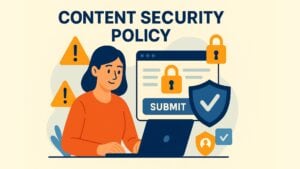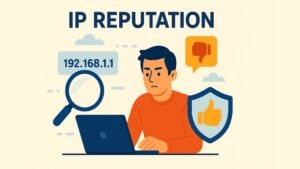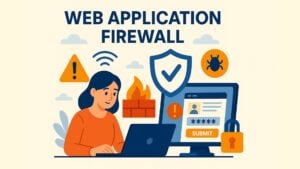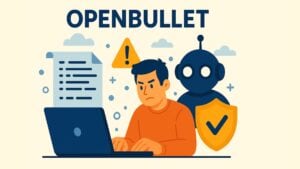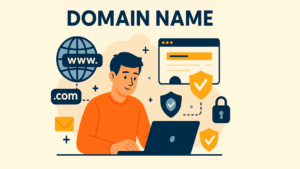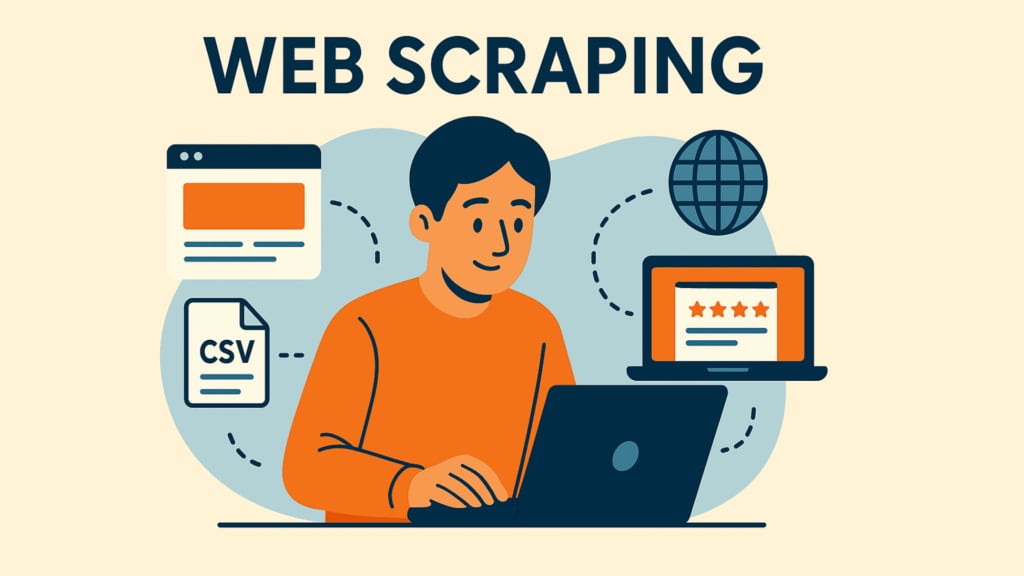
Imagine browsing the web, gathering all sorts of valuable data — product information, pricing, or customer reviews — without ever manually visiting each page. Web scraping does just that, using automated tools to collect information from websites quickly and efficiently. It’s a process that extracts content from web pages, often at a scale and speed impossible for a human to achieve.
Web scraping involves sending a request to a website and collecting its data. This data is then organized into a useful format. It can include pricing details from e-commerce sites, product descriptions from manufacturers, or social media posts for sentiment analysis. Web scraping helps gather information from the vast web landscape for various purposes. However, it has both positive and negative implications depending on how it’s used.
Table of contents
How Web Scraping Works
Web scraping generally follows a few basic steps, though the process can vary based on the tools and data involved. First, the scraper sends a request to the target website. The website responds with its HTML code, which is the foundation of most web pages. The scraper then reads and analyzes this HTML to extract specific information, such as product prices, stock availability, or customer reviews.
Once the data is retrieved, it’s parsed and formatted into a structure that’s easy to work with, such as a CSV file or a database entry. This makes the data ready for further analysis, reporting, or integration with other systems.
Although web scraping may seem straightforward, the scale at which it can be done is impressive. Instead of collecting data manually from one page at a time, scraping can automate the process to gather thousands of pages across multiple sites within minutes. Thats making it an invaluable tool for businesses, researchers and marketers alike.
Benefits of Web Scraping
Web scraping isn’t inherently harmful. When used ethically, it offers several legitimate benefits. For instance, search engines like Google depend on web scraping (or crawling) to index pages and display relevant search results. Similarly, price comparison websites rely on scraping to gather up-to-date product prices across different retailers, providing consumers with better choices. This kind of data extraction helps businesses and users access the latest information more quickly.
Market researchers often use web scraping to collect data from social media platforms, product reviews and forums. This data can reveal trends, track customer sentiment and provide insights into competitor activities. In the financial industry, real-time web scraping is commonly used to monitor stock prices, news updates, or economic indicators.
Web scraping can also streamline data collection for businesses in industries like travel, real estate, or retail, helping them gather critical information quickly for analysis or decision-making.
Threats of Web Scraping
When web scraping is used maliciously, it can cause significant issues for businesses. One of the most common problems is content theft. Scrapers can quickly copy and republish your unique product descriptions, images, or articles. This may result in duplicate content, which can lower your search engine rankings. The damage affects both your brand’s reputation and your SEO performance.
In e-commerce, competitors might use web scraping to monitor your prices continuously. With this information, they can undercut your pricing automatically, often leading to price wars that eat into profit margins. Similarly, scraping bots can put undue strain on your website’s resources, leading to slower page loads, downtime, or even a complete crash — especially during peak traffic times.
Security vulnerabilities can also emerge from scraping. Malicious actors may use scraping to collect personal data, such as email addresses, or to identify weaknesses in your site that could be exploited for hacking. In some cases, they may scrape large amounts of data for phishing campaigns or other fraudulent activities.
Web Scraping Tools
Web scraping tools are designed to automate the process of collecting data from websites. These tools come in various forms, from simple browser extensions to complex software platforms capable of scraping multiple websites at once. Below are a few common types of web scraping tools used by developers, businesses and researchers.
1. Beautiful Soup (Python Library)
One of the most popular web scraping tools is Beautiful Soup, a Python library that makes it easy to parse HTML and XML data. It’s beginner-friendly, offering both simplicity and flexibility. Beautiful Soup allows users to navigate a webpage’s structure and efficiently extract relevant information. While it requires some programming knowledge, it’s often used alongside other Python libraries, such as Requests for sending HTTP requests and Pandas for data analysis.
2. Scrapy
Scrapy is another powerful open-source Python framework designed for large-scale web scraping projects. Unlike Beautiful Soup, which is primarily focused on parsing HTML, Scrapy is built to handle the entire scraping process. It includes tools for handling requests, following links, parsing data and saving it in various formats. Scrapy is best suited for users who need a robust and scalable solution for scraping multiple websites simultaneously.
3. Octoparse
For those looking for a user-friendly, no-code solution, Octoparse is a popular tool. Octoparse offers a visual interface that allows users to design scraping tasks by pointing and clicking on the elements they want to extract from a webpage. It supports both basic and advanced scraping, such as handling paginated content and scraping dynamic websites. Octoparse is ideal for non-programmers or businesses who want to get started with web scraping without the need for coding skills.
4. ParseHub
Similar to Octoparse, ParseHub is a powerful, easy-to-use scraping tool that features a point-and-click interface. It can handle complex web scraping tasks, such as scraping data from JavaScript-rendered pages or websites that require user interaction (like logging in). ParseHub’s visual editor simplifies the process and its support for multiple data formats makes it suitable for various applications, from market research to content aggregation.
5. WebHarvy
WebHarvy is a point-and-click web scraping software that automatically identifies data patterns on websites. It’s particularly useful for those who need to extract images, URLs, product details, or other structured content. WebHarvy’s user-friendly interface and automation features make it an attractive option for small businesses or individuals looking to scrape data with minimal effort.
Preventing Malicious Web Scraping
Protecting your website from unauthorized scraping starts with identifying potential threats. When bots are scraping your site, they often do so in a manner that’s different from regular user behavior. Their requests are usually faster, more frequent and come from suspicious sources. But to effectively block malicious scraping, you’ll need a combination of strategies.
One of the simplest methods to block unwanted traffic is by implementing CAPTCHA challenges. These puzzles are designed to be easy for humans but difficult for automated bots to solve. By requiring users to complete CAPTCHA challenges before accessing certain pages or submitting forms, you can prevent scrapers from bypassing your site’s defenses.
Another useful technique is rate limiting, which restricts how frequently users can make requests to your server within a set time. If an IP address sends too many requests in a short period, you can slow down their access or temporarily block them. This helps prevent scraping bots from overloading your website and causing server issues.
Additionally, web application firewalls (WAFs) can detect and filter out malicious traffic before it even reaches your server. WAFs use various rules and algorithms to distinguish between legitimate traffic and scraping attempts, providing an extra layer of security.
While these technical measures can help, you also need to pay attention to your website’s content management. Make sure that your robots.txt file is configured correctly. This file tells search engine bots which pages should be crawled and indexed, though malicious bots may ignore it. Nonetheless, it’s still a good first line of defense.
Finally, some websites implement bot management solutions that use machine learning to detect patterns of suspicious activity. These solutions can distinguish between human users and bots based on behavioral cues and adjust security measures in real time to prevent scraping attempts.
Legal and Ethical Aspects of Web Scraping
While scraping publicly available data is generally legal, it becomes problematic when it violates terms of service, bypasses protection mechanisms, or uses the data in unlawful ways. For instance, ignoring a website’s robots.txt file or scraping copyrighted content is considered unethical and could lead to legal consequences.
Data privacy laws like GDPR (General Data Protection Regulation) in the European Union further complicate web scraping practices, especially when it involves personal data. Scraping websites that contain sensitive user information without consent could violate privacy laws and result in hefty fines or penalties. Businesses need to be aware of these legal risks and ensure their scraping activities stay within the bounds of the law.
Web scraping tools can also be used for malicious activities like phishing or identity theft, which are illegal. If you’re scraping data from websites, it’s essential to follow ethical guidelines and ensure you’re not infringing on the intellectual property or privacy of others.
Conclusion
Web scraping is an incredibly powerful tool that has become integral to various industries, enabling businesses to gather data at scale. Whether it’s for monitoring competitor prices, conducting market research, or gathering real-time data, scraping can provide valuable insights and save time. However, when used maliciously, it can cause significant harm, such as content theft, server overloads and security breaches.
To protect your website, it’s essential to employ a combination of security measures like CAPTCHA, rate limiting and advanced bot management. Additionally, staying compliant with legal and ethical standards is crucial, especially when handling personal data. For businesses seeking a privacy-compliant solution, CAPTCHA systems like captcha.eu offer a great way to prevent automated scraping without compromising user experience or violating privacy laws.
By staying proactive in protecting your website, you can mitigate the risks of malicious scraping and ensure your online presence remains secure and reliable.
FAQ – Frequently Asked Questions
What is web scraping?
Web scraping is the automated process of extracting data from websites using bots or scripts. It allows users to gather information such as product details, pricing, or customer reviews quickly and at scale, which would be otherwise time-consuming to collect manually.
Why is web scraping used?
Web scraping is commonly used for market research, price comparison, sentiment analysis, competitive analysis, and real-time data collection. It enables businesses and researchers to gather large volumes of data from multiple sources in an efficient and automated manner.
How can I protect my website from malicious web scraping?
To protect your website from scraping bots, you can implement various techniques such as CAPTCHA challenges, rate limiting, blocking suspicious IP addresses, using web application firewalls (WAFs), and setting up a robots.txt file. Advanced bot management solutions can also help identify and block malicious bots.
What tools are commonly used for web scraping?
Some common web scraping tools include Beautiful Soup and Scrapy (both Python-based), as well as no-code tools like Octoparse and ParseHub. These tools vary in complexity, from simple ones suitable for beginners to more advanced frameworks for large-scale scraping projects.
What are the risks of web scraping?
The risks of web scraping include content theft, price undercutting by competitors, server overload, and data privacy violations. Malicious scrapers can exploit vulnerabilities and misuse scraped data for fraudulent activities, which can harm businesses’ reputations and bottom lines.
Is web scraping legal?
Web scraping is legal when done within ethical boundaries. However, scraping data that violates a website’s terms of service, bypasses technical protections, or collects personal information without consent may lead to legal consequences. It’s important to respect intellectual property and privacy regulations like GDPR.
100 free requests
You have the opportunity to test and try our product with 100 free requests.
If you have any questions
Contact us
Our support team is available to assist you.
